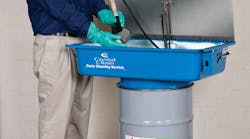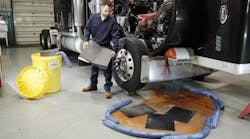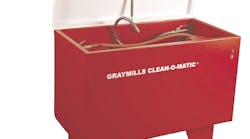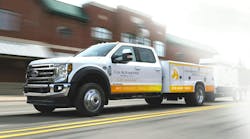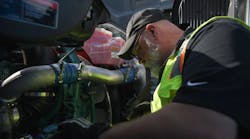Acquiring the appropriate parts washer - a machine where dirty parts, components and equipment can be cleaned - is not as easy a task as it may seem. As with any piece of shop equipment, not all parts washers are created equally.
Moreover, parts washers are offered in a range of cleaning solutions, specifications and levels of cleanliness, with a host of options. There are also different environmental concerns for the various types of parts washers.
To get the lowdown on parts washers, I contacted Safety-Kleen, a leading North American used oil recycling and re-refining, parts cleaning and environmental solutions company which provides a broad set of environmentally-responsible products and services (www.safety-kleen.com), and spoke with Sean M. Spaziani, the company's marketing director for environmental services and products.
1. What are the most common cleaning methods used by parts washer?
Spaziani says the most common cleaning methods used by parts washer are manual, automated, ultrasonic and immersion agitation.
- Manual cleaning. Typically a sink on a drum style or a vat style design.
Manual parts washers are best suited for a low volume of cleaning - generally less than 45 minutes per day, says Spaziani. They are also ideal for smaller parts where the contaminants can be removed with a brush under low pressure flow and the parts do not require a high level of clean.
- Automated cleaning. Automated parts washers are intended for operations where parts are cleaned more than 45 minutes per day. In this case, as a general rule, transitioning to an automated process would actually save money, he says.
Other considerations for automated cleaning:
- The number of parts cleaned per day requires a more automated approach.
- The parts being cleaned have a certain design where they can't be cleaned effectively through a manual process (i.e., blind holes).
- The level of clean required cannot be achieved in a manual process.
Spaziani says the most common automated parts cleaning methods are:
- High-pressure spray. These are cabinet-style washers that operate like a dishwasher where the parts are cleaned by being hit with high pressure spray from various angles while the parts rotates on some type of turntable to ensure a complete cleaning. Typically, heated, aqueous-based chemistries are used.
Aqueous-based solvents are water-based solutions and can be composed of detergents, alkaline chemicals, microbes or any combination of these. Instead of dissolving grease or solids, aqueous-based solvents use heat, agitation, soap action and time to break dirt into smaller particles.
High-pressure spray parts washers are "great for the harder-to-get-off stuff that may be baked onto a part, as well as the heavier greases and oils, and are most effective for cleaning exterior surfaces," Spaziani says.
"One big advantage here is that these units are typically very customizable and you can add conveyor systems, drying cycles, rinse cycles, etc."
- Ultrasonic cleaning. With these vat-style units, parts are immersed into a cleaning bath and hit with ultrasonic energy to produce high energy bubbles that vibrate contaminants off surfaces for a high level of clean. This is the preferred method for cleaning blind holes and crevices, and smaller parts.
"While a bit more expensive than other technologies, this method is chosen typically because the process, the 'clean' requirements or the design of the parts to be cleaned demand it," says Spaziani.
- Immersion agitation. With this type of parts cleaner, also a vat-style, the parts are immersed into the bath and are either agitated up and down or side-to-side on a tray, or hit with high-pressure spray under immersion or a combination of both.
Immersion agitation is "ideal" for both exterior and interior cleaning that spray alone and ultrasonics can't reach, and for removing contaminants that require soaking to break down effectively for removal.
"Since the part is immersed and needs to be brought back up through the contaminated bath, this method may not suffice when high levels of clean are required," he notes.
"Depending on what you are removing from the parts, simple agitation may not provide enough action or impact to remove the contaminants. Adding spray under immersion may help."
2. What factors need to be considered when selecting the best cleaning method for an application?
Considerations include:
- Material composition of the part to be cleaned.
- Design of the part(s).
- Size of the part(s).
- Characteristics of soil that you want to remove.
- Level of cleanliness required.
3. How do you choose the right cleaning chemistry to use in the parts washer?
Spaziani says the most common cleaning chemistries are petroleum and organic-based solvents, and specialty solvents.
Petroleum and organic-based solvents clean by breaking down or dissolving the contaminants. These solvents typically cannot be used in high-pressure spray or ultrasonic applications.
Specialty solvents are available to address niche cleaning operations and applications outside of routine repair and maintenance (i.e., solvents built to strip specialty inks and paints). There are also specialty solvents built to meet certain industry specifications, like for military specs and the food industry.
There are two important things to consider when selecting a solvent to clean parts, says Spazian.
- Watch the flashpoint. This is the lowest temperature at which a solvent gives off enough vapor to ignite when a flame or spark is present.
"Higher solvent flashpoints make safer products, but the higher you go on flashpoint, the slower the drying time and the lower the cleaning power.
"Find the right balance for your process, but typically, you can find a solvent with a flashpoint of between 141 and 160 degrees. This is not considered hazardous in most states and still cleans very well."
- Be aware of the volatile organic content (VOC) of the solvent.
"Certain states or areas of the country have very specific regulations regarding the usage, storage, management and reporting of VOC-based solvents. There are low-VOC and no-VOC solvents available that you can try but they are usually more expensive. If in a VOC-regulated area, aqueous chemistries are typically ideal.
"When selecting the right cleaning chemistry, always start with selecting the right cleaning method or process," emphasizes Spaziani. "At times, this will limit your choices on what chemistry you can use, and the cleaning method is usually much more important to setting up an effective parts washing process.
Whenever the process allows, beyond the obvious performance criteria, he recommends considering chemistries that meet as many as the following criteria as possible:
- Non-hazardous and can be recycled or reused.
- Has been proven to maintain its efficiency over an extended period of time.
- Provides the best experience for workers in terms of odor, risk and performance.
"This usually starts by considering an aqueous-based cleaning solution that has a pH greater than 2 and less than 12, or by selecting a solvent with a flashpoint of greater than 140 degrees that does not contain any solvents listed on the EPA's hazardous waste list."
4. How can the spent parts washer waste be best managed?
It is very important to remember that there are two things to consider when determining whether or not parts washer waste will be hazardous and how to dispose of it properly, stresses Spaziani. They are the characteristics of the clean chemistry being used, and all the contaminants that are added to the bath during the cleaning process.
"It doesn't take a lot of chlorinated solvents or metals before your bath becomes hazardous. Don't leave this one to chance."
He advises consulting a professional at an environmental company, such as Safety-Kleen, to discuss the cleaning process and even possibly to do analytical testing in order to limit liabilities and ensure that the wastes are being managed within the regulations.
Furthermore, Spaziani suggests choosing a waste hauler that will:
- Protect a company by offering assurance and indemnification backed by enough assets to keep the business safe.
"Remember, you own the waste cradle-to-grave, and once you hand it to a waste hauler or service company, you have to count on them to do the right thing. Make sure you are protected."
- "Choose the safest, most responsible and most environmentally responsible means of disposing of your parts washer waste. Your preference here should always be to either seek a recycling option, or to make sure it's sent to a reprocessing facility that meets all regulatory requirements."
Keep in mind, he adds, it's not just the cleaning chemistry that may be hazardous. Any rags, filters or personal protective equipment used while cleaning parts may be hazardous as well and needs to be managed accordingly.
What's more, "some baths that are deemed hazardous can usually be tracked back to the use of aerosols in or around the parts cleaning solution. Especially when those aerosols contain chlorinated solvents. Managing this contamination potential may help you stay non-hazardous."
5. Is there the need for a full-service parts washer provider and what value does that add?
In addition to owning one's own parts washers, another option is to contract to have them managed. Having a full-service provider helps remove the headaches, unnecessary costs and liabilities associated with managing a parts washing operation.
One of benefits to having a full service parts washer provider, observes Spaziani, is that parts washers can be rented, and all repairs, maintenance and replacements covered.
Another benefit is regularly scheduled service of parts washer, which helps to protect the equipment. "It's proven that by having regular service on your parts washer, you can extend its life by up to five times and greatly reduce the number of failures."
Regularly scheduled service also helps maximize the cleaning capabilities of the cleaning chemistry, he notes. "Over-extending your bath life can sometimes result in cleaning times of over three times, and your costs to go up. It takes longer to get the part clean, extra wipe down time, techs start using aerosols to supplement the process and overall morale goes down as well.
"By not having your employees do the services themselves, you limit their exposure to the chemicals, reduce the potential for workplace injuries, reduce the likelihood of a spill, and keep them making money for you.
"If you choose Safety-Kleen, you get a certificate of assurance and indemnification to protect you and your business, you get the broadest range of options as far as chemistries and disposal options in the industry so you can make the right choice for you and your business, and we'll support you and your team with highly-trained service and environmental health and safety professionals to keep you up and running, informed, in compliance, supported and as green as your processes will allow."
6. What are some things to watch out for when choosing parts washers?
Finally, Spaziani offers these cautions when deciding upon a parts washer:
- Watch out for unproven technologies. "There are new technologies popping up every day that have no current market presence and haven't been properly tested. Being their guinea pig can put your business in danger."
- Be wary of pricing that is too low. Get involved and be aware of where your waste is going. If the price is too good to be true, it may be that wastes are being improperly disposed of.
- Know how much time your people are spending cleaning parts. "When companies actually measure this, they are typically amazed at the lost work time and profit leakage. Automating your cleaning process can sometimes be a huge win for you and your company.
- Watch out for hidden costs. "It is a very rare occurrence when managing your own parts washer actually saves you money. The costs are just spread out and/or hidden. When you take the time to add them up, you'll find having a provider was the best decision all along."
- For those shops that use aerosols, watch your aerosol usage. "Often times shops develop bad habits of using aerosols to clean parts. This is an extremely costly mistake and sometimes takes businesses years to figure out how much they've lost. Use a parts washer for washing parts and the costs will go down on the aerosol side dramatically."
